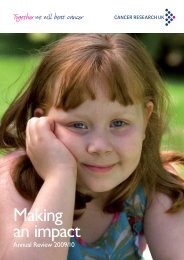Presentation slides about the literature review - Cancer Research UK
Presentation slides about the literature review - Cancer Research UK
Presentation slides about the literature review - Cancer Research UK
You also want an ePaper? Increase the reach of your titles
YUMPU automatically turns print PDFs into web optimized ePapers that Google loves.
Breakthrough Breast <strong>Cancer</strong><br />
Awareness Campaign: ISM<br />
Literature Review<br />
Jo Freeman & Douglas Eadie<br />
6 th December 2007<br />
ISM Institute for Social Marketing
Literature Review Objectives<br />
• Explore current knowledge/perceptions<br />
of breast awareness & screening<br />
• Identify factors which hinder uptake of<br />
screening appointments<br />
• Review intervention studies aiming to<br />
promote screening uptake<br />
• Review existing public info campaigns
Methods<br />
• Six databases searched<br />
• ‘Grey’ <strong>literature</strong><br />
• Small archive of materials
Structure of Review<br />
3 main areas:<br />
1. Knowledge, awareness and attitudes<br />
towards breast cancer and screening<br />
2. Intervention studies<br />
3. Public information campaigns
Attitudes Towards Breast <strong>Cancer</strong><br />
• Considerable amount of fear regarding<br />
breast cancer<br />
– ‘a death sentence’, ‘<strong>the</strong> Big C’, ‘disaster’
Awareness of Risk Factors<br />
• Low awareness & confusion <strong>about</strong> risk<br />
factors<br />
– especially re. age, inherited risk
Breast Awareness<br />
• Limited knowledge of signs & symptoms<br />
– aware of breast lump being a symptom<br />
but very limited knowledge of o<strong>the</strong>r<br />
symptoms<br />
– particularly older women, ethnic<br />
minorities & socially disadvantaged<br />
groups
Breast Awareness<br />
• Confusion between breast awareness &<br />
breast self-examination<br />
• Delay in presentation complex but<br />
several predictors<br />
– misattribution of symptoms<br />
– older age<br />
– non-disclosure of symptom to significant<br />
o<strong>the</strong>rs<br />
– negative attitudes towards GP/treatment<br />
– psychosocial factors, eg. (anxiety /<br />
denial)
Breast <strong>Cancer</strong> Screening<br />
• Limited / inaccurate knowledge of<br />
screening programme & eligibility<br />
• Attendance at screening predicted by<br />
– perceived importance of screening<br />
– beliefs re. consequences<br />
– attitudes of significant o<strong>the</strong>rs<br />
• Barriers to screening<br />
– fear of pain/discomfort<br />
– gender/cultural differences
Problem Areas<br />
* Fear – need reassuring messages<br />
* Signs & symptoms – need to increase<br />
awareness of wide range of symptoms<br />
* Risk factor knowledge, particularly re.<br />
age<br />
* Breast awareness v breast selfexamination<br />
* Knowledge of screening programme
Breast <strong>Cancer</strong> Intervention<br />
Studies<br />
• Wide range of strategies employed:<br />
– interventions aimed at women on an<br />
individual level<br />
– interventions aimed at GPs / health<br />
professionals / health centre staff<br />
– multi-strategy interventions
Breast <strong>Cancer</strong> Intervention Studies<br />
• Most effective:<br />
– ‘fixed’ invitation appointments<br />
– good evidence for self-completion<br />
‘action plan’<br />
– flagging of patient records<br />
– education / training of health centre staff<br />
– culturally specific-based education /<br />
promotional activities<br />
– multi- strategy interventions
Breast <strong>Cancer</strong> Intervention Studies<br />
• Less effective:<br />
– ‘open’ invitations<br />
– free transport to screening clinic<br />
– inclusion of self-completion health<br />
questionnaires with invitation
Public Information Campaigns<br />
Main <strong>UK</strong> campaign organisations<br />
Emphasis on:<br />
– Awareness raising and information giving<br />
(not changing behaviour)<br />
– Unpaid media (PR approaches)<br />
– Stand alone written materials (esp.<br />
leaflets)<br />
– Receptive audiences<br />
– Broad initiatives and partnerships<br />
– Multiple goals and objectives
Public Information Campaigns<br />
• Less on:<br />
– Who is accessing <strong>the</strong>se campaign<br />
materials<br />
– How materials are being used<br />
– Their impact on knowledge and<br />
behaviour
Overview<br />
Messages and materials<br />
• Two broad categories:<br />
– Diagnosis, treatment and <strong>the</strong>rapies<br />
– Risk factors and early detection (inc. primary<br />
prevention)<br />
• Most combine screening and breast<br />
awareness messages (eg. 5-point code)<br />
• Some more narrowly focussed (eg. TLC)<br />
• Self-examination also featured<br />
• Sometimes part of a broader campaign
Overview<br />
Communication formats:<br />
• Mainly written (Internet, posters,<br />
postcards, leaflets etc)<br />
• Some DVD and VHS teaching packs<br />
• Also some innovative reminder products<br />
• Links with personalised support a<br />
common feature
Gaps & Opportunities<br />
Target groups:<br />
• Ethnic minorities (esp. breast awareness)<br />
• Socially disadvantaged<br />
• Over 70s<br />
• Pre-screening age group<br />
Approaches:<br />
• Educational packages (eg. DVD, CD Rom)<br />
• Inter-personal support (eg. link-workers)<br />
• Alternative community channels (eg. community<br />
groups, ethnic media, local authority premises)<br />
• Local publicity events (eg. roadshows)


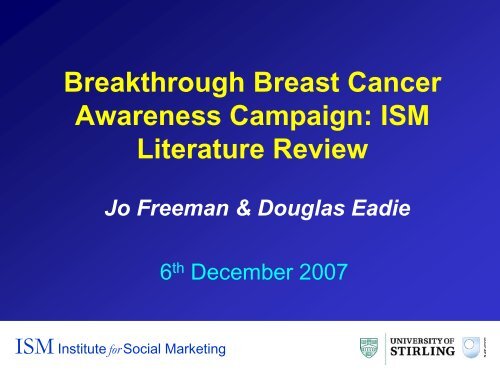
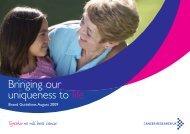
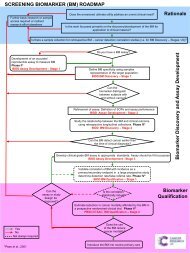
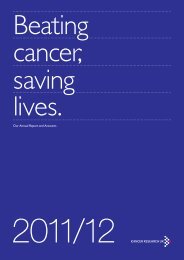

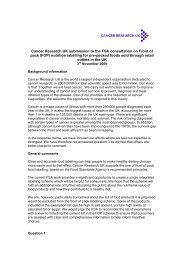
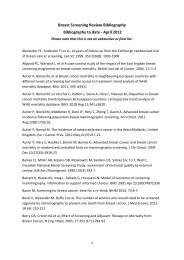
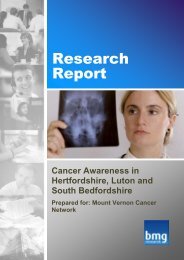
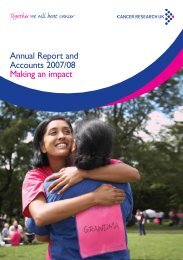
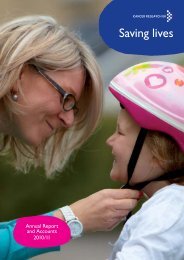
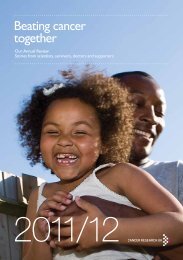

![[PDF] Cancer Research UK's strategy 2009 - 2014](https://img.yumpu.com/29239422/1/184x260/pdf-cancer-research-uks-strategy-2009-2014.jpg?quality=85)
